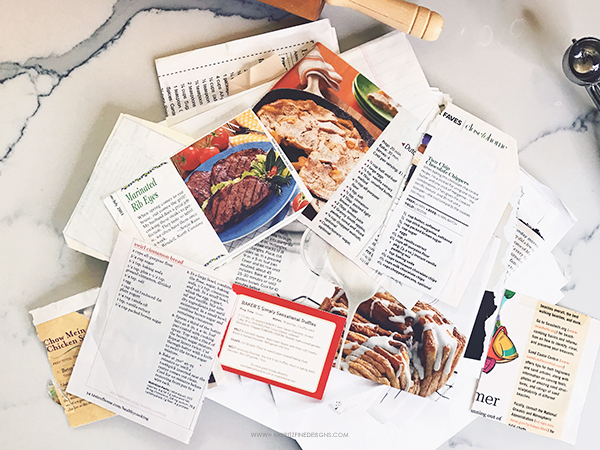Meal Planning for Busy Parents
Why It’s Hard and How to Make it Easier
If I had one day’s meal plan for every time I’ve sworn to the gods on high that I’m really going to start meal planning — FOR REAL THIS TIME — and then quit after one over-hyped meal-gone-wrong, I’d probably have a month’s worth of menus mapped out.
Maybe you’re thinking: why would I get meal planning advice from you??
Fair point.
But I actually think that, having given up so many times before, and being the kind of person who feels inclined toward meal planning but apparently isn’t (obviously), I may actually be a decent conveyor here. (And for the record, I actually do now meal plan…) So there.
I’ve culled the depths of food blogs and influencers, nutritionists’ and dieticians’ advice, and spoken with countless friends and family members about meal planning. The following tips come from various avenues, and you don’t need to use all of them. Rather, I suggest you pick and choose what resonates with you. Start small and keep it simple, friends. Don’t go all Martha Stewart from day one. Take it from someone who’s been there: overambition is a fast track back to square one.
Benefits of Meal Planning
Once you get over the initial hurdle, there are so many great things about meal planning. Let’s review, in brief:
- That question — “what’s for dinner??” — is no longer a sticking point. My kids used to ask me this all the time, and I would stall, and they would keep asking, and I would get (unfairly) annoyed at them for continuing to ask, and the cycle went on… Now, no more. They ask; I check my chart; I answer; and that’s that.
- All complaints can be directed at the meal plan — not you. (As in, “sorry, I didn’t decide we’re having steel cut oatmeal for breakfast, that’s just what’s on the list.”)
- It resituates the burden of deciding what to have when for what meal from a high-stress time (namely, the evenings) to a lower-stress time when it feels like less is on the line. It’s TIRING to decide what to do for dinner, especially at the end of the day when between work and home you may have already made a thousand other decisions about things no one else pays attention to… Not having to make one more choice in the moment truly feels like a gift.
As one mother told a group of researchers: “It’s not the cooking as much as it is the planning that makes me dread the 5 o’clock hour (sorry Jimmy Buffett (RIP)). When I’m organized enough to make these decisions the night before, or in the morning, and take advantage of the two Crock Pots I own, I feel better about dinner.” Amen.
- You can incorporate more balance and greater variety. Kids learn to like new foods simply by trying them; and by planning things out, it’s much easier (possible??) to keep track of what your children have eaten in any given week.
For example, before I was meal planning, I remember realizing at some point that my kids had had toast for every single breakfast for as many days as I could remember. It was easy, I admit, but less than ideal… Similarly, if I’m planning things out from more of a bird’s eye perspective, I can make sure I don’t schedule bagel sandwiches for breakfast and paninis for dinner on the same day (because, let’s face it, that’s an awful lot of bread…). When you see what you’re eating/serving on paper, it’s an automatic invitation to be more mindful of choosing balanced menus and working in a greater variety of foods.
Okay, let’s get to it, shall we?
1. Wade In
At the risk of repeating myself… it’s easy to burn out quickly if you dive in the deep end. Meal planning need not be an all-or-nothing endeavor, nor must it look pretty. (The last thing we need is yet another exhibition to keep up with…)
Especially if you’re just getting started, you want to strike a balance between planning things out specifically enough that it’s actually helpful (i.e., we’re having baked chicken with roasted rosemary potatoes and green beans rather than we’re having meat, a starch, and a veggie) but not getting too far into the weeds (aka, meals that involve multiple new time-intensive recipes). Nay, to begin, keep it realistic.
There are multiple ways to start small:
- Pick themed nights, such as Taco Tuesday or Stir Fry-days.
- Pick one meal to focus on — i.e., breakfast, lunch, or dinner — and plan only that meal for one week.
- Pick your busiest, most stressful nights and start by just planning meals for those nights.
- Divide and conquer — if you have a partner in parenting, divvy up the days (ie, someone takes M/W, someone else takes T/Th – and eat out on Fridays!). This has the benefit of spreading the work equitably and you always know who is responsible which nights. There is no ambiguity!
A note: Meal planning involves making a map of menus for some predetermined period of time — it’s not synonymous with meal prepping, which entails actually getting food ready/prepared (washing/cutting/chopping/cooking/mixing/etc) to eat later on.
2. Make Time to Plan
This, I think, may have been my biggest problem getting started — and I doubt I’m the only one. I greatly underestimated how long it takes to plan one week of meals.
Part of the reason meal planning is hard for most of us is because we’re consolidating a lot of thinking and strategizing — one week’s worth — into a single block of time. I expected to whip up a meal plan in minutes — and while this may be possible for recipe gurus or veteran meal-planners, it’s not usually true for beginners.
Meal planning takes time — this is where most people fall short and it’s also why they give up.

For your first foray, try to find a reliable chunk of time (some writers suggest 20-30 minutes, but my first few weeks, it took me nearly an hour) to sketch things out. One common piece of advice is to turn meal planning into a kind of self-care session (“enjoy a glass of wine or a cup of tea,” “turn on relaxing music,” etc.) — and while I think this is a fantastic idea, I also think it overlooks the fact that recipe-hunting and menu-scheduling may not be at the top of everyone’s list when it comes to “Me Time.” Not to mention, not everyone has the time and/or resources to devote to meal-planning in this way.
For me, knowing this^ actually made the task more enjoyable: I felt grateful to be able to do it in the first place.
In any event, when you first start out, expect it to take longer than you think.
3. Document, document, document
Keep records of everything. If you find a food blogger whose recipes you love, mark it down. If you discover a salad recipe your kids like, mark it down (and please, please, tell me what it is). If you have meal ideas that aren’t tied to any specific recipe, mark those down too.

You need to make note of:
- Recipes to consider trying
- Recipes you’ve tried and liked/would “keep” (aka recipes that your kids actually eat)
- Weekly menus
- Grocery lists (keep an eye out for ingredients you don’t have on hand or usually buy — it stinks to forget!)
You can do this however you like, of course, so long as you do it. Some folks find that a formal record-keeping mechanism sparks inspiration and also acts as an accountability check.
If you like writing things out by hand, you can use notecards for recipes, simple PDF printouts for weekly menus, or pick from any number of meal-planning notebooks available online (such as this one, which has handy tear outs for grocery lists).
For those who prefer to store these things digitally, there are some great apps and online tools available (Plan to Eat, Prepear, MealPrepPro, and Paprika recipe manager are oft-mentioned favorites).
Personally, I am a pen-to-paper kind of person, but I’ve actually found that I do best to use a simple Google Doc for meal-planning. I like how easy it is to add to, edit, and markup. Plus, I love that I can click through to recipe links right from my plan. I only plan breakfasts and dinners, BTW, and I set it up with an easy outline on the side, like this:
For each week, I have a simple chart I fill in for my kids’ meals (please, friends, spare me your comments on the specifics here…):
I keep a printed copy of these charts on my refrigerator door for easy reference.
The point is less how you keep track of your recipes and menus than that you do it. There’s no right way.
Some parents like to make a little more of a display out of things, which is also great for kids, who like to see what’s going on. You could always use a simple whiteboard, but there are lots of fun, pretty options available on Etsy if you’d like something a little more decorative.


4. Consider Your Calendar
This is HUGE, friends. You want to make a meal plan with your schedule at your side. For any afternoons/evenings when your kids have something scheduled and you know you tend to be running late, be sure to pick something quick and easy. If you have a huge deadline coming up at work and need to get in early, consider quicker, on-the-run breakfasts. Alternatively, if it’s going to rain on Saturday and you don’t have plans, maybe that’s a great time to try a more time-intensive recipe that your kids can help with.
Seasonality plays a role here, too — I find that it always feels like I have more time to cook in the winter (it gets dark at like 4pm where I live…), so I’m more willing to feel good about cooking projects in the afternoons than during the summer, when it’s nice and everyone wants to just stay outside forever.
In short: consult your calendar and choose menus that fit your timing.
5. Find Your Trusted Recipe Reserves
Like a microcosm of meal-planning itself, this is extremely time-consuming on the front end, but a major time-saver in the long run. Try to find a few different go-to spots you can turn to for recipes or inspiration, otherwise it’s just too much. Because there is SO MUCH out there. It’s easier to check one, two, or three places you know and trust for a good recipe for black bean burgers than it is to google “black bean burgers recipe.” Talk about going down the rabbit hole…

Here is where you need to know yourself: personally, I’m terrible at following directions, so I need recipes that are low-ingredient and pretty straightforward. My family is also vegetarian, so I favor sites that cater to that. And some of it just boils down to personal preference, of course. It’s hard for me to get excited about a recipe when it’s buried in an all-text cookbook and I can’t envision the final product; and I cannot stand food blog recipe pages that are cluttered with ads and pop-ups, slow down my device to a standstill, and demand that you scroll through 4,000 words of their life story and background information on the making of the recipe. But some people enjoy those details (I presume?).
Don’t forget to ask around! Solicit recipes and suggestions from your parents and friends — I spent an embarrassingly long amount of time scouring the internet for a simple, no-frills lasagna recipe before it occurred to me that my family is Italian, and maybe I should just call my mom. 🤦🏻♀️ Especially if you have a friend with a similar palate, exchanging recipes is a great way to beef up your repertoire with little to no effort.
If you’re looking for a great place to start, I might point you to The Kitchn, which not only has an incredibly rich online recipe book and fabulous recipe roundups, but is *very-user friendly in its presentation. Each recipe page has a “jump to recipe” button up top that takes you straight to the actual recipe, and it also includes the ingredient amounts in the recipe directions so you don’t have to constantly look back and forth, which is just straight up genius.
In short: find your recipe people.
6. Take Shortcuts Where You Can
Don’t make meal-planning any harder than it needs to be. There are so many ways you can cut corners. For example:
- Use leftovers! They count! (I use leftovers for my kids’ lunches, and therefore feel exonerated from planning lunch entirely, hah.)
- Reuse your own meal plans. If you had even a few weeks built up, you could easily recycle them or swap out just one or two meals if you wanted to try something new. Don’t feel like you have to reinvent the wheel every week.
- Many bloggers and food writers share weekly meal plans — consider using a pre-made meal plan from any such spots.
- Take out counts!
- Trade with a friend — make a week and swap with a friend. Two for the price of one.
7. Don’t Stress, & Leave Room for Flexibility
If you miss a few days or even a week — or stray from your plan in any way — don’t worry! It’s totally fine. Life happens, I think we all know by now… The whole point of meal planning is to make things easier. So if something else comes along that presents as easier, go with what works. And don’t think twice about it!

If there’s ever a week you just can’t find the time to plan things out, refer back to a previous week (this, again, is why it’s so helpful to keep track of things). Or, you could plan a “safe week” of easy, crowd-pleasing menus that you can always fall back on if, say, someone gets sick, or there’s a snowstorm and school’s closed for three days, or it’s just one of those weeks.
Likewise, if you find yourself in the need of swapping something, or trading in one thing for another, that’s fine. Don’t sweat it. We also have a few “always yes” foods at our house that my kids know I will pretty much always agree to serve alongside the regularly scheduled menu (edamame, apple slices, beans, hummus, and an egg — not all at once!). These are all foods they (usually, hah) like, so it takes the pressure off anything new/unfamiliar, and they’re quick, filling, no-prep additions.
Friends, we’re not going to pretend that a menu chart can or will “solve” The Dinner Problem — because this isn’t just an “individual, family” problem. Something so many of us share in is not individual. This is a social thing, a cultural thing, an economic thing; a time thing and a money thing and a women’s right thing (though I know families where the men do ALL the cooking too!).
It’s not merely us.
And it’s not merely dinner.
And maybe there’s no real solving the “problem” anyway.
Making a menu map isn’t a quick fix. But maybe it can help in the meantime.
Hi! Thank you so much for this great article and for so many good ideas based on excellent resources. I wanted to share my blog with your readers since I have lots of posts about all of these topics from the perspective of a busy working mom (pediatric neurologist). I don’t sell anything – just lots of posts on meal planning, prepping, kid related topics, and much more . http://www.smartmamamd.com
For you Brit — check out https://www.feastingathome.com/. I’m obsessed with the recipes and have had good success with many of them with my kids! As for a “salad” that kids love, does sliced cherry tomatoes tossed with a dash of Costco pesto count?! My kids (2 & 3yrs) gobble it up!
I’ve found menu planning helpful for many years. I use the AnyList app (basic version) to build my grocery list AND my menu. I’ll admit…I don’t plan breakfasts and lunches are almost always leftovers or something super simple like a wrap. I’m able to add a “menu” category and list out my receipts in the items (with links) so each night I just hop in there, pick a recipe and go. I love it for inspiration when I’m stuck. I just scroll through old recipes and in no time I can build my menu for the week. I do love to try new recipes so each week we have 1-2 new things to try and I do save the more complex recipes for the weekend when I know I have extra time to prep.